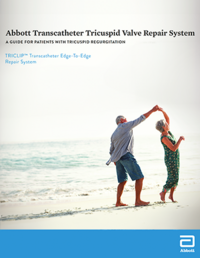TRICUSPID VALVE REPAIR
Tricuspid Regurgitation
treatment options
Tricuspid regurgitation, often referred to as a leaky tricuspid valve, can vary in severity from mild to severe tricuspid regurgitation, depending on how well the valve functions. Treatment for tricuspid regurgitation focuses on improving your heart’s function, alleviating symptoms, and minimizing complications. Treatment options are determined based on how severe the condition is, what caused it, and any underlying heart or health issues.1

MEDICATION
Your doctor may prescribe medications to help manage some of your symptoms, such as diuretics (water pills) to remove excess fluid from your body, or medications to treat an underlying condition that is causing tricuspid regurgitation.1

SURGERY
If tricuspid valve repair is an option for you, a surgical technique called an annuloplasty may be performed. This procedure typically involves the implantation of a device to tighten or replace the ring around the tricuspid valve (annulus) so that the valve leaflets can close properly. When needed, other tricuspid techniques may be used to repair the valve.

TRANSCATHETER
EDGE-TO-EDGE REPAIR (TEER)*
If your doctor and heart team determines that open-heart tricuspid valve surgery is not an option—due to age, advanced heart failure, or other associated medical conditions—a minimally invasive, non-surgical treatment option called TriClip™ TEER may be a possibility.
Why choose Tricuspid Valve Repair
with TriClip TEER?
If you've been diagnosed with severe tricuspid regurgitation, choosing the right treatment option is crucial for improving your heart's function and overall quality of life. For many patients, tricuspid valve repair using the TriClip™ TEER procedure is an excellent option, especially for those who may not be suitable candidates for open-heart surgery. Here’s why:
- Minimally Invasive Approach: Unlike traditional tricuspid heart valve replacement, which often requires open-heart surgery, TriClip TEER is a minimally invasive procedure. A small clip is delivered through a vein in your leg and attached to your tricuspid leaflets to help the valve close more completely. This helps to restore normal blood flow through your heart.2
- Preserves Your Natural Valve: With TriClip, there’s no need to replace the valve. The clip helps your own tricuspid valve close properly, improving blood flow and reducing symptoms–while maintaining a functional native valve.
- An Option for High-Risk Patients: For patients with advanced heart failure or other health conditions that make open-heart surgery too risky, TriClip TEER offers a safer alternative, helping to treat severe tricuspid regurgitation without open heart surgery.
- Improves Quality of Life without open heart surgery: Many patients find relief from symptoms like fatigue, swelling, and difficulty breathing after the TriClip procedure. It may help you get back to your daily activities and improve your overall well-being.
- Proven Results: Studies have shown that TriClip TEER is an effective option for treating severe tricuspid regurgitation, providing lasting relief from symptoms and reducing further heart complications.2
DISCUSS ALL TREATMENT OPTIONS WITH YOUR DOCTOR
Your doctor can describe the risks and benefits and help you decide which option is right for you.
A Guide for People With Tricuspid Regurgitation
Download the tricuspid regurgitation treatment guide to learn more about a minimally invasive transcatheter tricuspid valve repair option.

The information provided is not intended for medical diagnosis or treatment or as a substitute for professional advice. Consult with a physician or qualified healthcare provider for appropriate medical advice.
MAT-2413350 v1.0 | Item approved for U.S. use only.